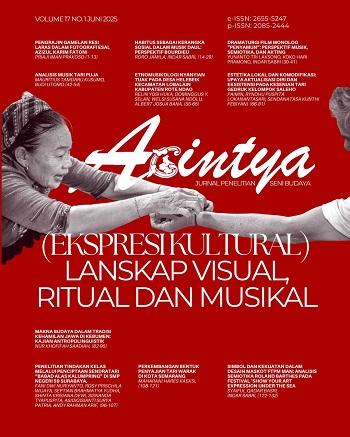HABITUS AS A SOCIAL FRAMEWORK IN DAUL MUSIC:BOURDIEU'S PERSPECTIVE
DOI:
https://doi.org/10.33153/acy.v17i1.7136Keywords:
musik daul, habitus, kapital ekonomi, kapital sosial, kapital budaya, kapital simbolik, piere bourdeuAbstract
This research aims to analyze Ul-daul music from the perspective of Pierre Bourdieu's sociological theory, with a focus on the concepts of habitus and capitals, including economic, social, cultural, and symbolic capitals. Ul-daul music in Madura functions not only as entertainment but also as a means to build social spaces and cultural identities. This study addresses the following questions: How does Ul-daul music shape social interactions and community dynamics in Madura? And how does habitus influence behavior patterns in the practice of Ul-daul music? This study employs a qualitative approach, collecting data through interviews, observations, and documentation. This approach allows researchers to gain a deeper understanding of Ul-daul music's role in Madurese society. The main concepts used are Bourdieu's theories of habitus and capital, which include economic, social, cultural, and symbolic aspects. Habitus explains the habits and patterns of behavior that develop in the Ul-daul community. The capitals reveal how factors such as the economy, social status, and cultural symbols play a role in strengthening and preserving this musical tradition. The results demonstrate that Ul-daul music serves as more than just entertainment; it is also a social symbol that strengthens Madurese cultural identity. Ul-daul music also plays an important role in shaping the social structure and culture of Madura.
Downloads
References
A. Kinseng, R. (2017). Structugency: A Theory of Action. Sodality: Jurnal Sosiologi Pedesaan, 5(2). https://doi.org/10.22500/sodality.v5i2.17972
Afdhal, A., Prihatina, E., Siregar, Y. A., & Hidayat, R. (2023). Kontestasi Aktor di TikTok Dalam Mencapai Popularitas. The Journal of Society and Media, 6(2), 444–465. https://doi.org/10.26740/jsm.v6n2.p444-465
Amir, F., & Wrahatnala, B. (2023). Inovasi dan Transformasi Musikal dalam Grup Patrol Bhâkch Kêrrêng Rampak Pandhalungan. DESKOVI : Art and Design Journal, 6(1), 15. https://doi.org/10.51804/deskovi.v6i1.9348
Apdillah, D., Zebua, R. B., Idham, M., & Anhar, I. (2022). TEKNOLOGI DIGITAL DI DALAM KEHIDUPAN MASYARAKAT. Selodang Mayang: Jurnal Ilmiah Badan Perencanaan Pembangunan Daerah Kabupaten Indragiri Hilir, 8(2), 101–107. https://doi.org/10.47521/selodangmayang.v8i2.247
Ardiyasa, I. P. (2021). Strategi Peningkatan Stakeholder Baru Organisasi Seni Pertunjukan. JURNAL TATA KELOLA SENI, 7(1), 21–30. https://doi.org/10.24821/jtks.v7i1.4205
Asquith, L. (2019). Bourdieu and Social Capital. In Rebuilding Lives After Genocide (pp. 27–45). Springer International Publishing. https://doi.org/10.1007/978-3-030-14074-8_2
Bayu Aji, N. (2023). MUSIK TONG-TONG SANGGAR SENI TARARA, BANGKALAN, MADURA. Keteg: Jurnal Pengetahuan, Pemikiran Dan Kajian Tentang Bunyi, 23(1), 71–77. https://doi.org/10.33153/keteg.v23i1.5399
Dewojati, C., & Nadhilah Nurtalia. (2023). Konsep Habitus Bourdieu dan Dinamika Masyarakat Tionghoa dalam Pendidikan Jang Kliroe dan Korban Dari Peroentoengan. Arif: Jurnal Sastra Dan Kearifan Lokal, 3(1), 1–23. https://doi.org/10.21009/Arif.031.01
Elfena, L., Nurhadi, N., & Nurcahyono, O. H. (2020). Arena Produksi Kultural Kerajinan Kulit di Surakarta Dalam Tren Ekonomi Kreatif. Jurnal Socius: Journal of Sociology Research and Education, 7(2), 121. https://doi.org/10.24036/scs.v7i2.244
Fitriasari, P. D., Hamsyah, M. I., & Danugroho, A. (2023). Apropriasi Seni Musik Gugah Sahur: Studi Kasus Tongklek Tuban dan Tong-Tong Madura. Resital:Jurnal Seni Pertunjukan, 24(1), 46–57. https://doi.org/10.24821/resital.v24i1.8410
Fredianto, D., & Septiawan, F. E. (2020). Pawai Miniatur Truk sebagai Arena Hiburan Baru Masyarakat Rural: Sebuah Praktik Sosial. JURNAL SATWIKA, 4(1), 10. https://doi.org/10.22219/SATWIKA.Vol4.No1.10-21
Halik, F. (2012). ROKAT BHUJU’ VIS-À-VIS KOMPOLAN (Metamorfosis Elit Madura Pasca Keruntuhan Orde Baru). Karsa: Journal of Social and Islamic Culture, 119–131. https://doi.org/10.19105/karsa.v12i2.137
Križaj, J., & Doupona, M. (2021). Acquiring embodied and institutionalized cultural capital. Kinesiology, 53(2), 226–235. https://doi.org/10.26582/k.53.2.5
Mikton, C. (2010). Preventing intimate partner and sexual violence against women: taking action and generating evidence. Injury Prevention : Journal of the International Society for Child and Adolescent Injury Prevention, 16(5), 359–360. https://doi.org/10.1136/ip.2010.029629
Mistortoify, Z., Haryono, T., Ganap, V., & L. Simatupang, G. R. L. (2014). Pola Kellèghãn dan Teknik Vokal Kèjhungan Representasi Ekspresi Budaya Madura dan Pengalaman Estetiknya. Resital: Jurnal Seni Pertunjukan, 15(1), 1–17. https://doi.org/10.24821/resital.v15i1.796
Nagara, G. (2021). Peran Kapital pada Media Sosial: Pertarungan Kuasa Wacana Tri Rismaharini di Twitter dengan Analisis Jaringan Sosial. Jurnal Pemikiran Sosiologi, 8(1), 64. https://doi.org/10.22146/jps.v8i1.68244
Nugroho, T. S. A. (2021). Musik Tongtong Sebagai Pemberdayaan Ekonomi dan Identitas Lokal Masyarakat Kabupaten Sumenep Madura. Jurnal Seni Nasional Cikini, 7(1), 23–30. https://doi.org/10.52969/jsnc.v7i1.110
Putnam, R. (2001). Social capital: Measurement and consequences. Canadian Journal of Policy Research.
Putri, S. E. (2022). REALITAS FUNGSIONAL SAWERAN DALAM PESTA PERNIKAHAN. Jurnal Analisa Sosiologi, 11(4). https://doi.org/10.20961/jas.v11i4.61737
Raditya, A., H.T, F., & Christianto, W. N. (2019). Rute Kultural Musik Populer Di Madura. JURNAL SOSIAL : Jurnal Penelitian Ilmu-Ilmu Sosial, 20(2), 69–84. https://doi.org/10.33319/sos.v20i2.44
Rahmawati, N., Hastuti, H. B. P., Syaifuddin, N., & Mulyadi, N. (2021). AKTIVITAS SASTRA DI UNIVERSITAS HALU OLEO (Literature Activity in Halu Oleo University). Kandai, 17(2), 217. https://doi.org/10.26499/jk.v17i2.2978
Ramdani, R. F., Heriyawati, Y., & Herdini, H. (2022). Korelasi Praktik Sosial Pierre Bourdieu Dalam Karier Kesenimanan Yus Wiradiredja. Gondang: Jurnal Seni Dan Budaya, 6(1), 204. https://doi.org/10.24114/gondang.v6i1.34745
Richardson, J. (1986). Pierre Bourdieu 1986 - The forms of capital. Handbook of Theory and Research for the Sociology of Education.
Ritzer, G., & Goodman, D. (2006). Postmodern Social Theory. In Handbook of Sociological Theory (pp. 151–169). Springer US. https://doi.org/10.1007/0-387-36274-6_8
Small, N. (2017). Pierre Bourdieu. In Handbook of the Sociology of Death, Grief, and Bereavement (pp. 116–127). Routledge. https://doi.org/10.4324/9781315453859-11
Soemaryatmi, S. (2022). STUDI PUSTAKA TARI SRIMPI MUNCAR GAYA YOGYAKARTA DAN GAYA MANGKUNAGARAN SURAKARTA. Acintya : Jurnal Penelitian Seni Budaya, 13(2), 204–218. https://doi.org/10.33153/acy.v13i2.4123
Syarief, D. M., Abiyyi, U. S., Amini, U. H., Resmanti, M., & Wirajaya, A. Y. (2022). HABITUS MASYARAKAT KRAPYAK KIDUL KOTA PEKALONGAN TERKAIT TRADISI LOPIS RAKSASA. CaLLs (Journal of Culture, Arts, Literature, and Linguistics), 8(1), 105. https://doi.org/10.30872/calls.v8i1.6289
Wrahatnala, B. (2021). CONGWAYNDUT: REFLEKSI FUNGSIONALISME STRUKTURAL SENI PERTUNJUKAN YANG MELINTAS BATAS. Acintya Jurnal Penelitian Seni Budaya. https://doi.org/10.33153/acy.v12i2.3576
Downloads
Published
How to Cite
Issue
Section
License
Copyright (c) 2025 roro jamila, Indar Sabri

This work is licensed under a Creative Commons Attribution 4.0 International License.
Author continues to retain the copyright if the article is published in this journal. The publisher will only need publishing rights




